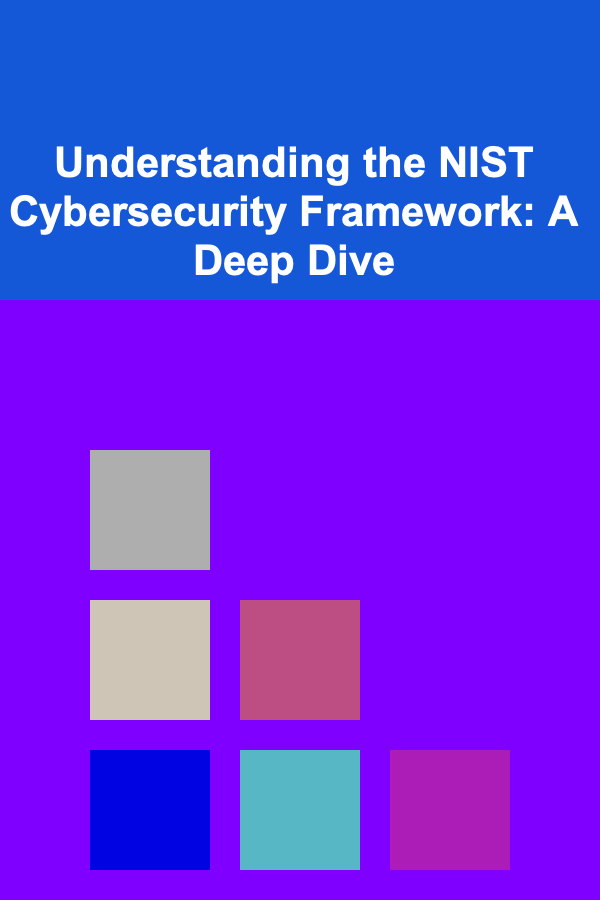
Understanding the NIST Cybersecurity Framework: A Deep Dive
ebook include PDF & Audio bundle (Micro Guide)
$12.99$10.99
Limited Time Offer! Order within the next:

In today's interconnected world, cybersecurity is paramount for organizations of all sizes and across all industries. The increasing sophistication and frequency of cyber threats necessitate a robust and adaptable approach to protecting critical assets and data. The National Institute of Standards and Technology (NIST) Cybersecurity Framework (CSF) has emerged as a globally recognized and highly influential framework for improving an organization's cybersecurity posture. This document provides an in-depth exploration of the NIST CSF, its components, its application, and its benefits, offering a comprehensive understanding for both beginners and experienced cybersecurity professionals.
What is the NIST Cybersecurity Framework?
The NIST CSF is a voluntary framework consisting of standards, guidelines, and best practices to manage cybersecurity-related risk. It is not a prescriptive checklist but rather a flexible, risk-based approach that allows organizations to tailor their cybersecurity program to their specific needs, risks, and resources. Developed by NIST in response to Executive Order 13636, "Improving Critical Infrastructure Cybersecurity," the CSF has since broadened its scope to be applicable to any organization seeking to improve its cybersecurity. It provides a common language and structure for communicating about cybersecurity risk, enabling better collaboration and understanding between different stakeholders, including IT professionals, business leaders, and regulatory bodies.
Key Principles of the NIST CSF
- Risk-Based: The CSF prioritizes risk management, helping organizations identify, assess, and mitigate their most critical cybersecurity risks.
- Flexible: The framework is adaptable and can be customized to fit the specific needs and context of any organization, regardless of size, industry, or complexity.
- Voluntary: Implementation of the CSF is voluntary, but it provides a valuable framework for organizations seeking to improve their cybersecurity posture.
- Common Language: The CSF provides a common language and structure for discussing cybersecurity risks and related issues, promoting better communication and collaboration.
- Continuous Improvement: The CSF emphasizes a continuous improvement approach, encouraging organizations to regularly review and update their cybersecurity program to adapt to evolving threats and technologies.
The Structure of the NIST Cybersecurity Framework
The NIST CSF is organized into three main components: the Framework Core, Implementation Tiers, and Framework Profiles. Understanding each of these components is crucial for effectively applying the framework.
1. Framework Core
The Framework Core represents the high-level functions, categories, and subcategories that provide a structured approach to managing cybersecurity risk. It is the heart of the CSF and defines the desired cybersecurity outcomes. The Core is divided into five Functions:
- Identify (ID): Develop an organizational understanding to manage cybersecurity risk to systems, assets, data, and capabilities. This function focuses on identifying the organization's assets, business environment, governance structure, risk assessment procedures, and risk management strategy.
- Protect (PR): Develop and implement appropriate safeguards to ensure the delivery of critical infrastructure services. This function focuses on implementing security controls to protect assets and data, including access control, awareness and training, data security, information protection processes and procedures, maintenance, and protective technology.
- Detect (DE): Develop and implement appropriate activities to identify the occurrence of a cybersecurity event. This function focuses on detecting security incidents in a timely manner, including anomalies and events detection, security continuous monitoring, and detection processes.
- Respond (RS): Develop and implement appropriate activities to take action regarding a detected cybersecurity incident. This function focuses on responding to security incidents effectively, including response planning, analysis, mitigation, and improvements.
- Recover (RC): Develop and implement appropriate activities to maintain plans for resilience and to restore any capabilities or services that were impaired due to a cybersecurity incident. This function focuses on recovering from security incidents quickly and efficiently, including recovery planning, improvements, and communications.
Each Function is further divided into Categories, which are groupings of cybersecurity outcomes closely tied to programmatic needs and particular activities. Categories are then broken down into Subcategories, which are specific outcomes that provide detailed guidance on achieving the objectives of the Categories. Each Subcategory includes informative references to existing standards, guidelines, and best practices that organizations can use to implement the subcategory. Examples of informative references include ISO 27001, COBIT, and NIST Special Publications.
For example, let's look at the "Identify" function. One of the Categories within Identify is ID.AM: Asset Management. A Subcategory within ID.AM is ID.AM-1: The organization's physical and software assets are identified and managed. The informative references for ID.AM-1 include CIS Controls v8 4.1, 4.2, 4.3, 4.4, 4.5, 4.6, 4.7, 4.8, 4.9, 4.10, 4.11, 4.12, 4.13, ISO/IEC 27001:2013 A.8.1.1, A.8.1.2, A.8.1.3, A.8.1.4, A.8.2.1, A.8.2.2, A.8.2.3, NIST SP 800-53 Rev. 5 CM-8.
2. Implementation Tiers
Implementation Tiers describe the degree to which an organization's cybersecurity risk management practices exhibit the characteristics defined in the Framework. They are not maturity levels but rather represent a progression in risk management sophistication. The Tiers are used to characterize an organization's current cybersecurity posture and its target state.
The four Implementation Tiers are:
- Tier 1: Partial: Risk management practices are ad hoc and reactive. Awareness of cybersecurity risk is limited, and risk management processes are not well-defined or consistently applied.
- Tier 2: Risk Informed: Risk management practices are informed by a general awareness of cybersecurity risk. Policies and procedures are in place, but they may not be consistently implemented across the organization.
- Tier 3: Repeatable: Risk management practices are formalized and consistently applied across the organization. Policies and procedures are regularly reviewed and updated. The organization demonstrates a more proactive approach to managing cybersecurity risk.
- Tier 4: Adaptive: Risk management practices are highly sophisticated and adaptive to changing threats and business needs. The organization continuously monitors its cybersecurity posture and adapts its risk management practices accordingly. There is a strong focus on continuous improvement and innovation.
Selecting the appropriate Tier is a critical decision. Organizations should consider their risk tolerance, budget, and regulatory requirements when determining their target Tier. Moving to a higher Tier does not automatically guarantee better security, but it does indicate a more robust and mature approach to cybersecurity risk management.
3. Framework Profiles
Framework Profiles represent an organization's alignment of the Framework Core functions, categories, and subcategories with its specific business requirements, risk tolerance, and resources. A Profile describes the current state and the desired state of an organization's cybersecurity program.
The Current Profile reflects the cybersecurity outcomes that the organization is currently achieving. It is a snapshot of the organization's existing cybersecurity posture. The Target Profile represents the desired cybersecurity outcomes that the organization wants to achieve. It is a roadmap for improving the organization's cybersecurity posture.
Developing a Framework Profile involves selecting the Core Functions, Categories, and Subcategories that are most relevant to the organization's business objectives and risk profile. This selection process should be based on a thorough risk assessment that identifies the organization's most critical assets, vulnerabilities, and threats. The Profile also specifies the Implementation Tier that the organization aims to achieve for each selected Subcategory.
For example, a small business might create a Profile that focuses on protecting sensitive customer data and preventing ransomware attacks. Their Target Profile might prioritize Subcategories related to access control, data backup and recovery, and security awareness training, aiming for a Tier 2 or Tier 3 implementation level for these critical areas.
How to Implement the NIST Cybersecurity Framework
Implementing the NIST CSF is a structured process that involves several key steps:
- Prioritize and Scope: Determine the scope of the CSF implementation by identifying the business objectives and critical assets that need to be protected. This step involves understanding the organization's mission, functions, and dependencies.
- Orient: Identify the organization's existing cybersecurity resources and capabilities. This includes understanding the current cybersecurity policies, procedures, and technologies in place.
- Create a Current Profile: Develop a Current Profile that reflects the organization's current cybersecurity posture. This involves assessing the extent to which the organization is currently achieving the outcomes defined in the Framework Core.
- Conduct a Risk Assessment: Identify and assess the cybersecurity risks facing the organization. This involves identifying potential threats, vulnerabilities, and the impact of a successful attack.
- Create a Target Profile: Develop a Target Profile that reflects the desired cybersecurity outcomes the organization wants to achieve. This should be based on the risk assessment and the organization's business objectives.
- Determine, Analyze, and Prioritize Gaps: Compare the Current Profile to the Target Profile to identify gaps in the organization's cybersecurity program. Analyze these gaps and prioritize them based on their risk and impact.
- Implement Action Plan: Develop and implement an action plan to address the identified gaps. This may involve implementing new security controls, updating existing policies and procedures, or providing additional training to employees.
- Measure Results: Regularly measure the effectiveness of the implemented actions and track progress towards achieving the Target Profile. This involves monitoring key performance indicators (KPIs) and metrics to assess the impact of the cybersecurity program.
- Review and Improve: Continuously review and improve the cybersecurity program based on the results of the measurement process and changes in the threat landscape or business environment. The CSF is not a one-time project but rather an ongoing process of continuous improvement.
Benefits of Using the NIST Cybersecurity Framework
Adopting the NIST CSF offers numerous benefits to organizations, including:
- Improved Cybersecurity Posture: The CSF provides a structured and comprehensive approach to managing cybersecurity risk, leading to a more robust and resilient cybersecurity posture.
- Enhanced Risk Management: The CSF helps organizations identify, assess, and mitigate their most critical cybersecurity risks, enabling them to make informed decisions about resource allocation.
- Better Communication and Collaboration: The CSF provides a common language and structure for discussing cybersecurity risks and related issues, promoting better communication and collaboration between different stakeholders.
- Increased Compliance: The CSF can help organizations meet regulatory requirements and industry standards related to cybersecurity. Many regulations and standards are aligned with the NIST CSF.
- Reduced Costs: By prioritizing risk management and focusing on the most critical threats, the CSF can help organizations reduce the costs associated with cybersecurity incidents.
- Improved Business Continuity: The CSF helps organizations develop and implement plans for resilience and recovery, ensuring business continuity in the event of a cybersecurity incident.
- Enhanced Reputation: Demonstrating a commitment to cybersecurity through the implementation of the CSF can enhance an organization's reputation and build trust with customers and partners.
- Facilitates Supply Chain Security: The CSF can be used to assess and manage the cybersecurity risks associated with an organization's supply chain. By requiring suppliers to adhere to the CSF, organizations can ensure that their data and systems are protected throughout the supply chain.
Common Challenges in Implementing the NIST CSF
While the NIST CSF offers significant benefits, organizations may encounter challenges during implementation:
- Lack of Resources: Implementing the CSF requires dedicated resources, including time, personnel, and budget. Small organizations may struggle to allocate sufficient resources to the implementation process.
- Lack of Expertise: Implementing the CSF effectively requires specialized cybersecurity expertise. Organizations may need to hire or train personnel to develop the necessary skills.
- Complexity: The CSF can be complex and overwhelming, especially for organizations that are new to cybersecurity. It is important to break down the implementation process into manageable steps and focus on the most critical areas first.
- Resistance to Change: Implementing the CSF may require changes to existing policies, procedures, and technologies. Employees may resist these changes, making it important to communicate the benefits of the CSF and involve employees in the implementation process.
- Maintaining Momentum: The CSF is an ongoing process of continuous improvement. Organizations may struggle to maintain momentum and ensure that the cybersecurity program remains effective over time.
- Integration with Existing Systems: Integrating the CSF with existing systems and processes can be challenging. Organizations may need to adapt their current systems to align with the Framework's requirements.
Tips for Successful NIST CSF Implementation
To overcome these challenges and ensure a successful NIST CSF implementation, consider the following tips:
- Start Small: Begin by focusing on the most critical areas of the organization and gradually expand the scope of the implementation over time.
- Seek Expert Assistance: Engage with cybersecurity consultants or experts who can provide guidance and support throughout the implementation process.
- Involve Stakeholders: Involve all relevant stakeholders in the implementation process, including IT professionals, business leaders, and employees.
- Communicate Effectively: Communicate the benefits of the CSF to employees and explain how it will improve the organization's cybersecurity posture.
- Develop a Realistic Plan: Develop a realistic implementation plan that takes into account the organization's resources, capabilities, and priorities.
- Prioritize Training: Provide adequate training to employees on cybersecurity best practices and the importance of following the CSF.
- Automate Where Possible: Utilize automation tools to streamline security processes and improve efficiency. This can include automated vulnerability scanning, intrusion detection, and incident response.
- Regularly Review and Update: Regularly review and update the cybersecurity program to adapt to changes in the threat landscape and business environment.
- Document Everything: Maintain thorough documentation of all aspects of the CSF implementation, including policies, procedures, and controls. This documentation will be invaluable for audits and compliance reviews.
- Focus on Continuous Improvement: Treat the CSF as an ongoing process of continuous improvement, not a one-time project.
The NIST CSF and Other Frameworks
The NIST CSF is not intended to replace other cybersecurity frameworks but rather to complement them. It can be used in conjunction with other frameworks, such as ISO 27001, COBIT, and the CIS Controls, to provide a more comprehensive approach to cybersecurity risk management. In fact, the Informative References within each Subcategory directly link to these other frameworks.
For example, an organization might use the NIST CSF to identify its critical cybersecurity risks and then use ISO 27001 to implement specific security controls to mitigate those risks. The CSF provides a high-level framework for managing cybersecurity risk, while other frameworks provide more detailed guidance on specific aspects of cybersecurity.
The Future of the NIST Cybersecurity Framework
The NIST CSF is constantly evolving to adapt to the changing threat landscape and the evolving needs of organizations. NIST continues to update and improve the framework based on feedback from users and experts. Future versions of the CSF are likely to include more guidance on emerging technologies, such as cloud computing, the Internet of Things (IoT), and artificial intelligence (AI).
The NIST CSF will continue to play a critical role in helping organizations improve their cybersecurity posture and manage cybersecurity risk effectively. Its flexibility, risk-based approach, and focus on continuous improvement make it a valuable tool for organizations of all sizes and across all industries.
Conclusion
The NIST Cybersecurity Framework is a powerful tool for improving an organization's cybersecurity posture and managing cybersecurity risk. By understanding the Framework's structure, components, and implementation process, organizations can effectively tailor their cybersecurity program to their specific needs, risks, and resources. While implementation may present challenges, the benefits of adopting the NIST CSF far outweigh the costs. By following the tips outlined in this document and embracing a continuous improvement approach, organizations can leverage the NIST CSF to achieve a more robust, resilient, and secure cybersecurity environment.

How to Maximize Storage During a Home Renovation
Read More
How to Soundproof Your Home on a Tight Budget
Read More
How To Program Swarm Robotics for Collective Behavior
Read More
How to Develop AR for Smart Cities
Read More
How To Choose the Best Lip Gloss for Your Style
Read MoreHow to Use a Home Maintenance Expense Tracker for Tax Deductions
Read MoreOther Products

How to Maximize Storage During a Home Renovation
Read More
How to Soundproof Your Home on a Tight Budget
Read More
How To Program Swarm Robotics for Collective Behavior
Read More
How to Develop AR for Smart Cities
Read More